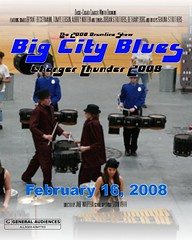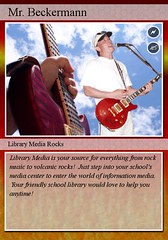Since the point of this is to tag and rank, let me start by adding my rank.
1. newsvine
2. digg
3. mixx
4. reddit
I thought newsvine was the easiest to look at and sort through. Digg is OK too. Mixx is not bad, and reddit is just hard on the eyes. It made me want to go away. I did set up acocunts with mixx and digg, but I'm not sure I'm interested in being a registered user. I'm more interested in using them as an unregistered visitor. I know this is a little counter-web 2.0, but I have found the greatest use with my advanced research students. When they are looking for contemporary, controversial topics, I like to send them to sites like digg, so they can see what the people are digging on. It gives them a better sense of what people are finding most important. For high school kids, that's a key. They need to develop a sense of what adults talk about and topics that are important in an adult world. Because of the ranking nature of these sites, it gives them a glimpse into that and helps them find topics. It also leads them to an initial article to stimulate their learning. So these can be enhancers. I've seen my students use them effectively, and I've discovered that they like to see what others think. As for being a registered member, I think I'll pass.
Friday, February 29, 2008
Thing 11. Tagging and Del.icio.us
I've been familiar with this tool for awhile, but I never took the time to set it up. I tended to store my bookmarks with the Google toolbar feature. With the login, that follows me where I go. The advantage of del.icio.us is that it allows the metatags. That's a handy sort tool.
I think, as with any of these tools, you need to pick and choose. The mere vastness of web 2.0 will drive you crazy unless you zero in on a few tools you really want to use well. Otherwise, I think we get sucked into the "mile wide, inch deep" dilemma.
That being said, I think Del.icio.us can have some classroom and media applications if you want it to. I currently list websites on my media center website, and I organize them into categories. The advantage of Del.icio.us is that users could search by metadata. The appearance is not as interesting as my own website (which could be a problem for teens who are always looking for the flash). However, it might made the use of the links more accessible. I'm afraid now that students don't take the time to search through the links. With the booksmarking site, they could search, which would be faster and easier. The key would be applying appropriate meta tags. For that, it would be important to think like a kid when setting them up.
Kids could also use it as a way to organize websites they find during their researching. I'm not sure how the tool bar download would work with so many users. I suppose my tech guy would just need to install it locally on all school machines, so kids could use it.
Overall, there is potential here. I may need to explore it further. Maybe it could even be built into research units (if teachers give me more time with their kids).
I think, as with any of these tools, you need to pick and choose. The mere vastness of web 2.0 will drive you crazy unless you zero in on a few tools you really want to use well. Otherwise, I think we get sucked into the "mile wide, inch deep" dilemma.
That being said, I think Del.icio.us can have some classroom and media applications if you want it to. I currently list websites on my media center website, and I organize them into categories. The advantage of Del.icio.us is that users could search by metadata. The appearance is not as interesting as my own website (which could be a problem for teens who are always looking for the flash). However, it might made the use of the links more accessible. I'm afraid now that students don't take the time to search through the links. With the booksmarking site, they could search, which would be faster and easier. The key would be applying appropriate meta tags. For that, it would be important to think like a kid when setting them up.
Kids could also use it as a way to organize websites they find during their researching. I'm not sure how the tool bar download would work with so many users. I suppose my tech guy would just need to install it locally on all school machines, so kids could use it.
Overall, there is potential here. I may need to explore it further. Maybe it could even be built into research units (if teachers give me more time with their kids).
Sunday, February 17, 2008
Thing 10: Wikis
I find Wiki's more interesting than thing 9. This could have some uses in the media center, maybe with book reviews as was displayed in one of the examples.
I did edit the 23 things on a stick Wiki. I added the following under "content suggestions:"
Another great tool
For those people who have website development skills, Google offers a neat tool to insert a Google-powered search engine into any existing webpage. It simply requires creating a Google account, go to more tools and click on custom search. http://www.google.com/coop/cse/ This allows you to create a search engine for whatever pages you want. We used it to search our school's webpage. Once the search is created, copy and paste the code into your page. It works very well. This may be more advanced, but I can see some people really liking it. For 23 things on a stick, the search could be pasted into the blog.
The whole wiki idea lends itself to an interesting dilemma. It's something that we adults do all the time--give and take information to form our own conclusions. The questions is: do kids have these skills? I'm not sure they do, so the next question is this: How do we equip kids with these skills? That's probably our biggest challenge.
Our English department bans Wikipedia as a cited source for research papers. I don't disagree with this, but I've come to find "good" uses for it in the research process. I've built Wikipedia into my research lessons, so kids can learn how to use it well. I have them use it to gain a general understanding of a topic and to find search words and subtopics. I find that Wikipedia is so well organized and easy to understand that it is the best tool available for providing students with this pre-researching information. Once they have gained this understanding, they are better equipped to use the subscription databases, books, etc. to find highly credible information. I also tell them this is a good starting point for finding web links. While not all the links are good, they are better than doing a general Google search because people obviously felt strongly enough about these sites to list them. They are generally better than average.
I'm very intereted in finding a way to add a library wiki to my website at school. that will be one of my goals.
I did edit the 23 things on a stick Wiki. I added the following under "content suggestions:"
Another great tool
For those people who have website development skills, Google offers a neat tool to insert a Google-powered search engine into any existing webpage. It simply requires creating a Google account, go to more tools and click on custom search. http://www.google.com/coop/cse/ This allows you to create a search engine for whatever pages you want. We used it to search our school's webpage. Once the search is created, copy and paste the code into your page. It works very well. This may be more advanced, but I can see some people really liking it. For 23 things on a stick, the search could be pasted into the blog.
The whole wiki idea lends itself to an interesting dilemma. It's something that we adults do all the time--give and take information to form our own conclusions. The questions is: do kids have these skills? I'm not sure they do, so the next question is this: How do we equip kids with these skills? That's probably our biggest challenge.
Our English department bans Wikipedia as a cited source for research papers. I don't disagree with this, but I've come to find "good" uses for it in the research process. I've built Wikipedia into my research lessons, so kids can learn how to use it well. I have them use it to gain a general understanding of a topic and to find search words and subtopics. I find that Wikipedia is so well organized and easy to understand that it is the best tool available for providing students with this pre-researching information. Once they have gained this understanding, they are better equipped to use the subscription databases, books, etc. to find highly credible information. I also tell them this is a good starting point for finding web links. While not all the links are good, they are better than doing a general Google search because people obviously felt strongly enough about these sites to list them. They are generally better than average.
I'm very intereted in finding a way to add a library wiki to my website at school. that will be one of my goals.
Thing 9: Online Collaboration Tools
I think this is my least favorite tool so far. While the online production tools aren't too bad (in fact, they are pretty good), I found the sharing cumbersome. Both tools are pretty straight forward and use easily recognizable tools shortcuts. That is helpful. I like how Google docs lets you revert to previous versions quite easily as well. It even has a trash can to store inadvertantly deleted versions. That could be a life saver. However, I'm not sure I see this as a huge time saver. I also wonder if several people could have the same document open at once. I guess if you were editing a shared document, it could be helpful. I had troubles opening the Jefferson piece. Maybe that's what turned me off on this.
Thing 8: Share Your Creations
Wow. This one took awhile, but I think my own curiosity make it take longer than it should have. I couldn't help but dig into each. I even set up my efolio at http://paulbeckermann.efoliomn2.com/index.asp
I liked the picture tools a lot. I posted a couple of them on my blog. I could see putting them into school web pages. The only thing I didn't like about it was that the link back to the service's website would be visible. I'm not big on advertising on a school web site. We already have so much of that in school with pop machines, scoreboards, etc.
I like the eFolio, but I'm not sure how I'll use it. I could link it off of my teacher web page at school. I like it as a way to keep track of resume ideas in case I ever need an updated one. I know schools are more interested in using this as a resume device, which makes sense.
The tools in general are not hard to use, although each offers its own unique user interface. It takes a little while to get used to but not bad. I'm more concerned about remembering all these logins and passwords. I'm also not sure if I'll remember which site had which tool. There are so many! They are cool though.
One last thought: I'm beginning to think that 23 things on a stick is actually 230 things on a stick. Each "thing" has so many subparts to it!
I liked the picture tools a lot. I posted a couple of them on my blog. I could see putting them into school web pages. The only thing I didn't like about it was that the link back to the service's website would be visible. I'm not big on advertising on a school web site. We already have so much of that in school with pop machines, scoreboards, etc.
I like the eFolio, but I'm not sure how I'll use it. I could link it off of my teacher web page at school. I like it as a way to keep track of resume ideas in case I ever need an updated one. I know schools are more interested in using this as a resume device, which makes sense.
The tools in general are not hard to use, although each offers its own unique user interface. It takes a little while to get used to but not bad. I'm more concerned about remembering all these logins and passwords. I'm also not sure if I'll remember which site had which tool. There are so many! They are cool though.
One last thought: I'm beginning to think that 23 things on a stick is actually 230 things on a stick. Each "thing" has so many subparts to it!
Sunday, February 10, 2008
Thing 7: Web 2.0 Communication Tools
At this time, my library doesn't promote the use of email too much. Most of this is staff to librarian and not student to librarian. I've had a few student email me with questions, but they weren't solicited. It's something I may explore, although I may need to direct these to my para at the desk. I can hardly keep up with my emails the way it is with teaching so much and also trying to be technology coordinator for my building and running the media center. The only problem is that I'm not sure she'd be able to help with the online research questions.
IM would be a similar challenge. I'd probably need to train my para to do this. It seems kids text much more than IM now. That has really changed in the past 6 months. However, students are not allowed to use cell phones during class, and after school, there probably wouldn't be a reference person available to answer them. Kids do have IM access between classes, but that's a busy time for my para with passes and supervision. I think email would be the best unless we could set up some sort of integrated online chat within my web page, but again, time and training would need to be addressed.
Personally, I'm not a big IMer to text messager. My cell phone is a pay as you go unit, so texting is not economical. I have done IMs, but it's not my first choice. I'd rather email or call a person. I'll call if I want to talk now and email if the response can wait. A phone call is faster for me than IM and cuts down misunderstandings. The benefit of IM would be if it was a bigger group online at one time, sort of like a conference call. That would be OK. Texting is also slow for me, but my kids are addicted.
I checked out the OPAL on web conferencing. Actually, I've been involved in 3 web conference recently at school. One was for state online testing. One was for a testing diagnostic tool, and the third one was a training session on Moodle. I really like the web conferencing. It is saving us money with training too, which is nice. We plan to do some staff Moodle training with a webinar, and this will save us over $100.
I think with any of these, you need to pick your poison and go with it. Find what works for you and use it.
IM would be a similar challenge. I'd probably need to train my para to do this. It seems kids text much more than IM now. That has really changed in the past 6 months. However, students are not allowed to use cell phones during class, and after school, there probably wouldn't be a reference person available to answer them. Kids do have IM access between classes, but that's a busy time for my para with passes and supervision. I think email would be the best unless we could set up some sort of integrated online chat within my web page, but again, time and training would need to be addressed.
Personally, I'm not a big IMer to text messager. My cell phone is a pay as you go unit, so texting is not economical. I have done IMs, but it's not my first choice. I'd rather email or call a person. I'll call if I want to talk now and email if the response can wait. A phone call is faster for me than IM and cuts down misunderstandings. The benefit of IM would be if it was a bigger group online at one time, sort of like a conference call. That would be OK. Texting is also slow for me, but my kids are addicted.
I checked out the OPAL on web conferencing. Actually, I've been involved in 3 web conference recently at school. One was for state online testing. One was for a testing diagnostic tool, and the third one was a training session on Moodle. I really like the web conferencing. It is saving us money with training too, which is nice. We plan to do some staff Moodle training with a webinar, and this will save us over $100.
I think with any of these, you need to pick your poison and go with it. Find what works for you and use it.
Thing 6: Trading Card
Here's my trading card. I liked the university use of them with the librarians being super heroes. However, I didn't see the options to make them as cool looking as they did. Maybe that was another template that I didn't see. I'll need to explore that some more. This could be a fun promotional tool. It could also be used in an English classroom to do Character trading cards when studying characterization.
Thing 5: Mashup Madness
Here's my attempt to put in some lettering Mashup work from Flickr. I decided to put in my new band's name to see if I could find anything cool. It's not bad, but I'm not sure I'd actually use it. I have a question about copyright as well. I'm assuming that these are public domain, but you know what they say about assuming . . .
I could see using a mashup, but I doubt that I'd actually make one. I don't have the writing skills for that, and I don't have the time to invest in learning it. I tried the retriever tool too. That is interesting, but I'd say it's more for fun than usefullness. Possibly an art teacher could make use of it when study shape and color to make connections with otherwise unrelated objects in the world. It might be a fun study.
I like the idea of posting images online if you are willing to give up your copyright to them. Otherwise, it gets too dicy and confusing for users. I just ran into a pretty tech savvy person who had no idea images online were copyrighted. Things are so easy to do online that people feel that everything you "can" do is OK. That's where the education part of the equation comes into play, of course, but it's hard to find time in the teaching day to get all these in. I try, but I'm afraid that with our limited time, our students' knowledge of these things is also limited.
One more note on Flickr--We had a concert at our performing arts center last night with our high school band and Concordia College band sharing the stage. It was a wonderful show, and I posted a couple images from the show on Flickr, so the director could use them if he wanted to. That was one immediate use I found with it--an image sharing tool.
Here's my mashup.







I could see using a mashup, but I doubt that I'd actually make one. I don't have the writing skills for that, and I don't have the time to invest in learning it. I tried the retriever tool too. That is interesting, but I'd say it's more for fun than usefullness. Possibly an art teacher could make use of it when study shape and color to make connections with otherwise unrelated objects in the world. It might be a fun study.
I like the idea of posting images online if you are willing to give up your copyright to them. Otherwise, it gets too dicy and confusing for users. I just ran into a pretty tech savvy person who had no idea images online were copyrighted. Things are so easy to do online that people feel that everything you "can" do is OK. That's where the education part of the equation comes into play, of course, but it's hard to find time in the teaching day to get all these in. I try, but I'm afraid that with our limited time, our students' knowledge of these things is also limited.
One more note on Flickr--We had a concert at our performing arts center last night with our high school band and Concordia College band sharing the stage. It was a wonderful show, and I posted a couple images from the show on Flickr, so the director could use them if he wanted to. That was one immediate use I found with it--an image sharing tool.
Here's my mashup.







Saturday, February 9, 2008
Thing 4: Flickr
I'm sort of a photo nut, so I found this to be fun. I felt a little restricted by the 100 mb limit on hosting space. That really doesn't allow for a lot of posting, certainly not if the images are print quality. For sharing online, I suppose you could get a couple hundred images out there, but print quality shots, you'd be lucky to host 25 or so. I understand why this is. Server space can get expensive, and they're giving this to us for free. I'm assuming there is a subscription upgrade, and that's how Library of Congress was able to upload more. I don't think I'll be throwing money into this, but it might be a neat way to share photos in a hurry.
As for a media center application, I could possibly see posting student work, but I think I'd opt for my local website first. We're also experimenting with Moodle, which is a more secure environment. I know I could restrict visibility on Flickr, but that sort of defeats the purpose in some ways.
I did really like the map feature. That was cool.
As for a media center application, I could possibly see posting student work, but I think I'd opt for my local website first. We're also experimenting with Moodle, which is a more secure environment. I know I could restrict visibility on Flickr, but that sort of defeats the purpose in some ways.
I did really like the map feature. That was cool.
Let It Out CD Cover
Here's my attempt at posting a picture from flickr to my Blogger blog. This is the cover of my 5th music CD. It's a self-portrait of my and my Gibson.
Subscribe to:
Posts (Atom)










